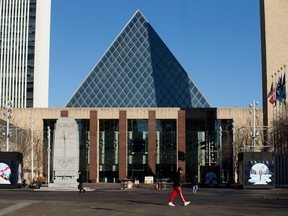
You can save this article by registering for free here. Or sign-in if you have an account.

Broad plans outlining where and how Edmonton could change and densify as the population grows are up for review at city hall.
Edmontonians are set to voice their opinions on the new district policy and district plans in what’s expected to be a lengthy, three-day public hearing from Tuesday to Thursday. Final approval could come by late summer or early fall if city council gives the green light this week.
Advertisement 2 Story continues below This advertisement has not loaded yet, but your article continues below. THIS CONTENT IS RESERVED FOR SUBSCRIBERS ONLYSubscribe now to read the latest news in your city and across Canada.
Subscribe now to read the latest news in your city and across Canada.
Create an account or sign in to continue with your reading experience.
If you are a Home delivery print subscriber, unlimited online access is included in your subscription. Activate your Online Access Now
Article contentHere’s what you need to know.
The district planning project breaks Edmonton down into 15 “districts” and creates a new planning policy that guides changes in all 15 plans.
It’s meant to give Edmontonians a clearer picture of where they can see more housing density, and more commercial activity built over time in each of the 15 areas as the city’s population grows to two million people.
The focus is mapping out “nodes” and “corridors” in each district, or hubs where the city wants more people to live by encouraging building more housing density through infill, and more commercial and employment activity particularly along busy routes in primary and secondary corridors.
Recommended from Editorial Edmonton to unveil new district plans to shape growth, redevelopmentEdmonton passes density-boosting zoning bylaw allowing three-storey apartments and row housing citywide
Small apartments could replace your neighbour's house in draft of Edmonton's zoning rewrite Edmonton: Here's what you need to know about how zoning changes may affect you Headline NewsGet the latest headlines, breaking news and columns.
By signing up you consent to receive the above newsletter from Postmedia Network Inc.
Thanks for signing up!A welcome email is on its way. If you don't see it, please check your junk folder.
The next issue of Headline News will soon be in your inbox.
We encountered an issue signing you up. Please try again
Article content Advertisement 3 Story continues below This advertisement has not loaded yet, but your article continues below. Article contentIt actions out the goals of the overarching City Plan, passed in 2020, by creating districts where locals can meet all or most of their daily needs within a 15-minute walk, bike, or transit trip from their homes.
What scale of development is appropriate for areas deemed nodes and corridors, what infrastructure is planned, and where bigger buildings can be built outside of those areas, is explained in the district policy.
Residents looking at the new plan for their districts can expect to see bigger buildings and most commercial activity in the nodes and corridors in their neighbourhoods in the coming years.
While the city wants the tallest buildings in the nodes and corridors, they expect a transition in height and activity moving deeper into existing smaller-scale residential areas.
But this doesn’t mean a tall apartment building or busy commercial area will be built next door tomorrow.
Zoning still determines how a parcel of land can be built or used. What the district planning project does, however, is set expectations for the kinds of changes that are encouraged.
Advertisement 4 Story continues below This advertisement has not loaded yet, but your article continues below. Article contentThat means parcels of land identified for higher housing density through this district planning process are more likely to be approved when developers ask city council to rezone the land. City administrators will recommend council approve rezonings that stick to the guidelines in these documents.
Being next to a transit station or park also makes it more likely taller buildings would be allowed there, even outside the nodes and corridors. The district policy says additional height for a property should be considered if at least two criteria points are met, such as being on a corner lot, along an arterial or collector roadway, next to a site zoned for higher density, or if it’s very close to a node or corridor.
“Priority growth areas” are also outlined for places with more intense residential and commercial development in the future.
Approving these new efforts also means discarding more than four dozen city planning documents, changing the futures of many neighbourhoods in Edmonton.
City staff are proposing to repeal 51 documents that outlined expectations for communities for years, including area redevelopment plans, neighbourhood structure plans, neighbourhood area structure plans, and area structure plans.
Advertisement 5 Story continues below This advertisement has not loaded yet, but your article continues below. Article contentThis process would also repeal the city’s residential infill guidelines policy, transit-oriented development guidelines policy, and the river valley development project RF3 architectural guidelines.
Many neighbourhood-level plans could be thrown out without any input from the people who live there. A series of staff reports available for the public hearing show the city didn’t receive any feedback about repealing plans in seven of the 15 districts.
“Administration did significant public engagement, including for the repeal of plans, as part of the district planning project in 2022 and 2023. In the West Henday district, members of the public did not share any feedback about the plans proposed for repeal,” one staff report states.
Read more about these plans on the city’s website.
Documents up for repeal without any input from residents include: